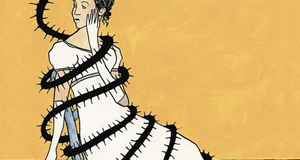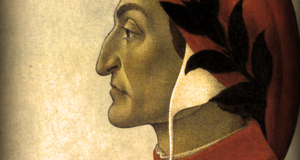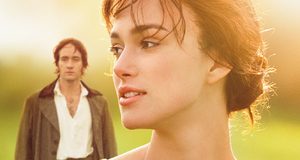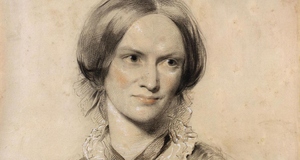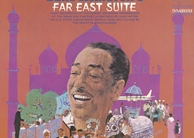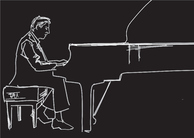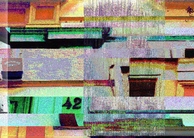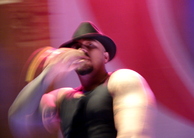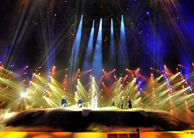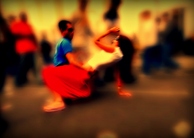Anti-Rhetoric in Alanis Morissette's "Mary Jane"
By
2010, Vol. 2 No. 04 | pg. 1/1
KEYWORDS:
Rhetoric is commonly regarded as the art of persuasion. To take it a step further, Gerard A. Hauser states that rhetoric is “An instrumental use of language. One person engages another person in an exchange of symbols to accomplish some goal. Rhetoric is communication that attempts to coordinate social action. Its goal is to influence human choices on specific matters that require immediate attention”. Following the logic of Hauser’s description of rhetoric as meant to persuade another person to action, any artifact that persuades another person not to action, but to inaction, would be considered a piece of anti-rhetoric. This is not considering inaction as an action in itself, but rather as passivity or a lack of particular response to stimuli. Such is the case in Alanis Morissette’s song, “Mary Jane.” In this essay, I argue that “Mary Jane” functions as a piece of anti-rhetoric, and that the metaphors used therein bring one to the conclusion that life (at least according to Morissette) is a difficult journey fraught with obstacles and that one can only hope to merely travel along the road and make it through. Alanis Morissette is a Canadian singer-songwriter born in 1974. She released her first record through MCA Records in 1991 only in Canada. Jagged Little Pill was Morissette’s breakthrough album—her third studio album, and first album to be released internationally. Concerning the writing process for Jagged Little Pill, Morissette is quoted in a video interview saying, “I write songs just basically based on inspiration and stream of consciousness. A lot of the songs on the record were written in about twenty minutes—just really quick, very uncensored, and there’s no premeditation on any of them. Music and lyrics written at the same time, just sort of in the room and I just give myself up to it and sometimes it comes flowing very quickly and other times it takes a little time but it eventually comes.” To prove my argument, I will be using the methodology of metaphor criticism. This methodology deals with the use of metaphor with specific regard to argument. According to Sonja Foss, in metaphor criticism, one must first examine the artifact as a whole, then isolate the metaphors, then sort the metaphors into groups in order to find patterns, and finally discover an explanation for the artifact (303-304). This methodology was largely furthered by “George Lakoff and Mark Johnson [who] were instrumental in introducing the notion that metaphor is pervasive in everyday language and thought” (Foss 302). Another major contributor was Kenneth Burke, who suggests, “that metaphor plays a critical role in the discovery and description of the truth” (Foss 302). I will also be employing the notion of anti-rhetoric—the art of persuading against action—which stems from Hauser’s description of rhetoric as “a means to an end, or as an instrumental mode of communication” (Hauser 59). He claims, “When rhetoric is understood in purely instrumental terms, the focus becomes the rhetor’s intended outcome with respect to some set of circumstances, as she understands them” (Hauser 59). Also essential to my argument is Lloyd F. Bitzer’s notion of exigence: “an imperfection marked by urgency; it is a defect, an obstacle, something waiting to be done, a thing which is other than it should be” (Bitzer 6). He states that, “an exigence is rhetorical when it is capable of positive modification and when positive modification requires discourse or can be assisted by discourse” (Bitzer 7). The first key metaphor Morissette uses to counsel inaction is “You lost your place in line again. / What a pity”. The very purpose of a line is to organize a group of people who are all trying to accomplish a similar goal: to “get” somewhere. Here, the nonchalance of the lyric, and the use of the word “again” imply that whatever Mary Jane was trying to accomplish—which was presumably important if there was a line of other people trying to accomplish it, as well—is actually insignificant and should perhaps not be bothered with. The lack of sincerity in the phrase “what a pity”, as well as the sarcasm society generally associates with that statement, reinforce this idea. The fact that Mary Jane lost her place in this line suggests that she was either stepped in front of or overlooked by someone else (because she appeared either weak or insignificant), or that she waited in this line and was for some reason forced to leave it (and thus wasted her time). This lyric overall says that Mary Jane waiting in this line to accomplish something was really just a bad idea from the start, and that she might as well not have bothered. The second metaphor emphasizing anti-rhetoric is “it’s a long way down on this rollercoaster. / The last chance streetcar went off the track and you’re on it”. The inevitable thing about rollercoasters is that once one has gotten on, one cannot get off until the ride is over; one must simply hang on to the bars or safety restraints and endure. Here the lyrics suggest that not only should one not bother trying, but also that even if one does try, there is nothing one can do to change the course of things. The lyrics also insinuate that the ride is not going to be smooth in the least, nor will it be over quickly. The next section of the lyric is arguing the triumph of Murphy’s Law: whatever possibly can go wrong will do so. Here, we see Mary Jane having yet another stroke of bad luck: the last streetcar of the night goes off its track. This is bad enough on its own; however, to make matters even worse, Mary Jane was actually physically on this streetcar and is now caught up in the chaos of this mishap, potentially injured in the derailing, presumably stranded in an inconvenient location, and assuredly late to wherever she was going. There is nothing Mary Jane can do to put the car back on the track or to catch another car; she would have been considerably better off not getting on it in the first place. The next portion of lyrics that suggests most profoundly that action is futile is “I hear you’re counting sheep again, Mary Jane. / What’s the point in trying to dream anymore? / I hear you’re losing weight again, Mary Jane. / Do you ever wonder who you’re losing it for?”. The lyrics come right out and ask what the point is in doing these things. Why dream if your hopes will only be crushed? Why try to look good if no one will appreciate you anyway? Morissette argues here that any kind of effort only results in disappointment, so to make these efforts is completely illogical and unproductive. She implies that pursuing happiness or satisfaction cannot possibly end as nicely as one anticipates; one will only encounter more discontent and most likely regret. The lyrics also give the impression that dreaming and losing weight, among other things, are endeavors that Mary Jane has been undertaking (and failing at) for quite a while. Logically, hint the lyrics, one should just give up these challenges after trying for so long with no success. Another example of the anti-rhetorical nature of this song is “Well, it’s full speed, baby, in the wrong direction. / There’s a few more bruises if that’s the way you insist on heading”. Here, Morissette states that Mary Jane is surely going the wrong way, in regards to life, but there is no going back now. She adopts the air of a frustrated parent who is fed up with trying to help a child in the right direction, and is now resigned to let the child do something inadvisable so that they might learn the hard way. This suggests that Mary Jane should really just give it up and go with the flow of things and the way people push her, regardless of whether or not she is inclined to do otherwise. The next set of lyrics adopts a softer tone: “You’re the sweet crusader and you’re on your way. / You’re the last great innocent and that’s why I love you”. Here, the annoyed and seemingly omniscient parent figure says that Mary Jane is getting there, slowly but surely, and despite her own stubbornness. It suggests that Mary Jane is hideously naïve and knows nothing of the ways of the world, which is why she keeps running into problems and being let down. The “I love you” serves to convince Mary Jane that this parent figure has Mary Jane’s best interests at heart, and that Mary Jane should just listen to her and her troubles will ease considerably. The final example of lyrics contending against action is “So take this moment, Mary Jane, and be selfish. / Worry not about the cars that go by. / Cause all that matters, Mary Jane, is your freedom. / Keep warm, my dear, keep dry”. Again, we see the lyrics implying that Mary Jane is inexperienced, and does not know any better than to hope for a nicer world. The lyrics counsel Mary Jane to abandon this cause, drop her concern for others, and simply take care of herself, as the rest of the people in the world take care of themselves. The lyrics then seem to send Mary Jane off with a final admonition not to get herself into trouble, i.e. cold or wet. Morissette says that if one simply keeps to the beaten path and does not anticipate anything overly joyful, one will make it through relatively unscathed. The entirety of Alanis Morissette’s “Mary Jane” serves as a metaphor for a hard journey, throughout which Morissette counsels that there is nothing helpful or useful to be done. She advises that no action can be taken that will succeed in making one utterly happy or making one’s life run perfectly smoothly, and thus one should simply not bother with taking any action at all. Going back to Burke, who says that metaphor may be used to uncover the truth, “Mary Jane” appears at face value to be merely a melancholy song pitying a sad character; however, once looked at under a metaphorical lens, an entirely different meaning emerges. Morissette throws Bitzer’s notion of exigence out the window, stating that nothing is capable of positive modification, and argues against making any choice on specific matters requiring attention, which Hauser describes as the entire point of rhetoric—thus turning the song “Mary Jane” into an anti-rhetorical artifact in popular culture. Alanis Morissette - “Mary Jane” Lyrics What’s the matter Mary Jane, had a hard day? Bitzer, Lloyd F. “The Rhetorical Situation.” Philosophy and Rhetoric 1 (1968): 1-14. Hauser, Gerard A. Introduction to rhetorical theory. Prospect Heights, Ill: Waveland, 2002. Print. Sonja, Foss K. Rhetorical Criticism: Exploration and Practice. 2nd ed. Long Grove, IL: Waveland, 1995. Print. Suggested Reading from Inquiries Journal
Inquiries Journal provides undergraduate and graduate students around the world a platform for the wide dissemination of academic work over a range of core disciplines. Representing the work of students from hundreds of institutions around the globe, Inquiries Journal's large database of academic articles is completely free. Learn more | Blog | Submit Latest in Music |








